-
There has been a recent SCI-FI, CLI-FI SHIFT!
While
the new genre of cli-fi is a female- driven phenomenon, with women writers, bloggers, literary critics and readers running the show!
Look around you.
It's plain to see.
It's in the air!
Interesting development.....developing.....
====================
13 Female "Cli-Fi" Writers Who Are Inspiring a Better Future
In the emerging genre of climate fiction, women take the helm
By Carly Nairn | Mar 8 2018
For International Women's Day 2018, we decided to honor those female writers bringing climate change to everyone’s minds and eyeballs through world-building, apocalyptic scenarios.
Pandemics, extreme weather, droughts, and a militarized process of securing natural resources are common elements in climate fiction, or “cli-fi”—and our anxiety-induced state makes this the perfect time for an artful examination of the future of the environment.
The writers listed here are questioning, critiquing, and speculating about what various kinds of worlds, including the one in which we presently live, can look like. In fact, the burgeoning genre of cli-fi has already sparked new avenues. Take solarpunk, a sub-genre that ultimately conveys an optimistic view of the future, often by envisioning how present political and cultural movements might realize their missions—such as Black Lives Matter, #TimesUp, #NODAPL, and the end of late-stage capitalism—and ultimately offering conclusions about how we can save ourselves from ourselves. Solarpunk and cli-fi stories are marked by conjecture about the future, critique of the present, and evaluation of the past. Frequently, environmental justice is a central theme, and humanity ultimately claims stewardship of the natural world.
This round-up includes works from cli-fi’s up-and-comers, as well as some best-sellers, and a nod to the legacy writers who started it all.
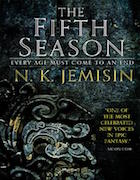 The Broken Earth Series by N.K. Jemisin
The Broken Earth Series by N.K. Jemisin
Back-to-back Hugo Award winner Jemisin brings a memento mori to life with the Broken Earth trilogy. The title of the first book, The Fifth Season, references an annihilation event that occurs every few centuries due to climate change. All of Jemisin’s work is steeped in mythology—characters understand their place within the hierarchy of “use-caste”; that is, until circumstances or natural grit compels them to undertake extraordinary endeavors.
Kingsolver is not your typical genre writer—she’s best known for mainstream best-sellers such as The Poisonwood Bible and the wonderful The Lacuna. Flight Behavior, on the other hand, feels like it could be a news report a few years down the road. A Tennessean housewife goes on a hike and finds a valley covered in millions of monarch butterflies whose usual winter grounds in Mexico have been displaced by climate change.
 Station Eleven by Emily St. John Mandel
Station Eleven by Emily St. John Mandel
Station Eleven is set in the Great Lakes region in the near-future, after a swine flu pandemic known as the "Georgia Flu" has devastated the world, wiping out most of the population. A troupe of actors tries to bring joy to those who are left by staging performances depicting life from a bygone era. The novel includes multiple character arcs that intersect and at times leave the reader guessing. Station Eleven is ultimately a story about the creative spirit within people, and how it can simultaneously shape and destroy our world.
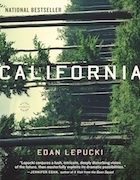 California by Edan Lepucki
California by Edan Lepucki
Post-apocalyptic California is becoming a common trope in cli-fi, but it holds sway in Lepucki’s astute portrait of human fragility. In the 2060s, a young couple finds out they are pregnant and decide to leave Los Angeles for the wilderness, so as to find a community that can help the young couple raise the kid. In this novel, “Communities” refer to havens of those wealthy and lucky enough to have survived after a flu ravaged most of the population. Like Silicon Valley’s real-life burgeoning community of wealthy and exclusive survivalists, California’s communities, located deep in the wilderness, include private security forces to protect those within them. Like most people who rely on cellphones, delivery services, and cheap transportation to get through the day, Frida and Cal are not your typical lovers of the outdoors, but still, they try to make life work in a world that won’t.
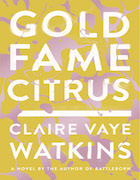
Gold Fame Citrus by Claire Vaye Watkins
Another novel set in a dystopian California, Watkins’s debut takes place in the near future, when the land is ravaged by extreme drought (this, of course, hits especially close to home for Californians). It hasn’t rained in years, and an expanding, shifting-sand hellscape reminiscent of the one portrayed in Mad Max, the “Amargosa Dune Sea,” has swallowed the Southwest. Los Angeles is left mostly abandoned. The main character is Luz, an orphaned model who as a baby was adopted by the Bureau of Conservation to be a poster child for water infrastructure expansion efforts—what a way to get famous. Watkins’s narration feels flimsy at times—you want to know more about Luz and why she makes the decisions she does. However, the story maintains suspense in that it’s difficult to choose who is more likely to survive—those in the Dune Sea, living each day like it’s their last, or those trying to make a world better than the one they currently inhabit.
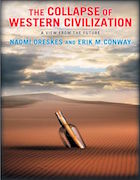 The Collapse of Western Civilization: A View from the Future by Noami Oreskes and Erik M. Conway
The Collapse of Western Civilization: A View from the Future by Noami Oreskes and Erik M. Conway
Oreskes is one of the few cli-fi writers who can safely say she has an insider’s take on the potentialities of climate change. As the affiliated professor of earth and planetary sciences at Harvard University, her daily life involves studies in geophysics and global warming. According to her novel, the collapse of western civilization happens in 2093, after the West Antarctic Ice Sheet disintegrates, and the global order is upended due to mass migration. The story takes place 300 years after the “Great Collapse” and is told through the point of view of a scholar in the Second People’s Republic of China, who writes about the human folly of not heeding earlier warnings of ensuing catastrophe.
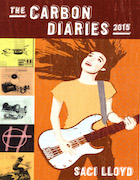 The Carbon Diaries: 2015 by Saci Lloyd
The Carbon Diaries: 2015 by Saci Lloyd
The Carbon Diaries: 2015 is a 2009 young adult novel set in the United Kingdom after weather disasters have left 16-year-old Londoner Laura weary of the future and a carbon-rationing program has been instituted. Nobody flies in a plane anymore, because it is too expensive, and each citizen’s carbon ration card has to be used on essentials, like starting home appliances and taking public transit. Reviewer Rebecca Onion touted the The Carbon Diaries as a prime example of a “soft apocalypse” story, in that it “chronicles societies changing as a result of a series of rolling crises, rather than in the blink of an eye, as from a nuclear blast.”
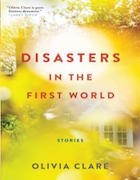 Disasters in the First World by Olivia Clare
Disasters in the First World by Olivia Clare
In Disasters, a short-story collection populated with imperfect people, drinking water in Las Vegas costs more than booze or drugs. An affront to the price of commodities, perhaps, but the scenario’s not as far-fetched as we would like to think, with major cities such as Cape Town presently on the brink of waterlessness. Clare, who’s mostly known for her poetry, is a master of language. Her fine-tuning is on full display in the story “Petur,” which was published in 2013 in Ecotone and fetched a 2014 O. Henry Prize. After a mother and son are stranded in a remote Icelandic town in the wake of 2010’s volcanic eruption of Eyjafjallajokull (what a name—and it’s real!), they suffer mental decline.
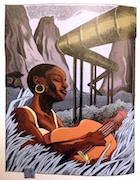 “Spider the Artist” by Nnedi Okorafor
“Spider the Artist” by Nnedi Okorafor
This short story, published online by Lightspeed Magazine, is set in a future Nigeria, where ecological destruction has taken root—“the fish, shrimps, and crayfish in the creeks were dying. Drinking the water shriveled women’s wombs and eventually made men urinate blood.” Okorafor, who has seen a boost in popularity following the recent announcement that her 2010 novel Who Fears Death will be adapted into an HBO series (with George R.R. Martin as executive producer), weaves elements of Nigerian folklore and history into all of her stories. In “Spider the Artist,” Zombies, or Anansi Droids—named after the African master storyteller who often takes the shape of an arachnid—guard a pipeline crucial to the Nigerian government’s control over its people and its ongoing supply chain to the United States.
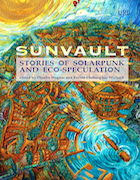 “A Catalogue of Sunlight at the End of the World” by A.C. Wise
“A Catalogue of Sunlight at the End of the World” by A.C. Wise
This short story, from Upper Rubber Boot Books’ Sunvault: Stories of Solarpunk and Eco-Speculation anthology, is told through diary entries that toggle back and forth through the 22nd and 23rd centuries. Set mainly in Svalbard, a Norwegian archipelago at the top of the world, one account illustrates the harsh beauty of aggravated circumstances. “Today the light is pure,” it states. “There isn’t a cloud in the sky to cut it, no breeze to stir it off our skins. All the shadows are sharp-edged. There’s so much of it, it’s easy to forget it’s there.” It’s always sunny at the end of the world, and the unnamed narrator reminisces about good and tough times, and about what’s to come next. Wise encapsulates the feelings of awe and dread that the natural world tends to inspire.
Now, let’s not forget the greats.
Many of the writers mentioned above would not be on this list if not for the shoulders of giantesses on which they stand. The following three authors are some of the best in the genre, period—and their legacies continue to haunt and astound us.
Butler, a cornerstone of Afrofuturism—an aesthetic, philosophy, and critique that explores intersections of African culture and technology—is unparalleled when it comes to world-building capabilities. The Parable of the Sower and The Parable of the Talents so eerily predicted the rise and election of Donald Trump that one might wonder whether Butler used a crystal ball when she got writer’s block. (This hypothesis, however, does a disservice to Butler’s narrative talent.) The Parable series, inspired by news reports about climate change and late-stage capitalism—and which Butler was never able to finish, due to her sudden and untimely death in 2006—conjures a world devastated by global warming. Drought and rising sea levels scourge the earth. Most people live in gated neighborhoods. Pharmaceuticals have replaced reality with psychotropic experiences. Women’s oppression is laid bare—“nags” who speak their mind get their tongues cut out. After President Donner, a nincompoop who promises jobs to the people, is elected, an opposition candidate, the charlatan Andrew Steele Jarret, dedicates his campaign to “making America great again.” It’s all very disturbing—especially when you find yourself nodding in agreement to teenage protagonist Lauren’s claim that, “People have changed the climate of the world.”
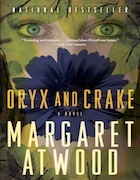 Margaret Atwood, best known for The Handmaid’s Tale, the MaddAddam trilogy, The Heart Goes Last
Margaret Atwood, best known for The Handmaid’s Tale, the MaddAddam trilogy, The Heart Goes Last
It would be difficult to argue that the cli-fi genre is what it is today—chock-full of talented writers who can conjure the strange, the tortured, and the triumphant—without Atwood having paved the way. In her MaddAddam series, readers are immersed in worlds defined by genetic engineering, religious zealotry, and internet and video culture—subjects so increasingly relevant that Atwood has become required reading in many schools. And yet, while reading Atwood, one cannot help but feel optimistic about the human capability to endure. In Oryx and Crake, the first book of the MaddAddam trilogy, a group of vegetarians are devoted to preserving all plant and animal life. They predict a natural disaster that will wipe out all species. When it comes to fruition, Atwood’s characters showcase the best and worst of humanity.
END OF POST
==================================
BELOW IS PRIVATE MOVIE FILES
- It was great fun, for one, to see the film in a large group of tora-san fans. There were times when people were giddy with anticipation as we all knew what was coming next. Its amazing how the original films still work and how much viewers get into it......it was fun to see the scenes and skits from previous films redone with different characters. it was a tora-san film, in the end, though without atsumi it was really more a "wish you were here" than a "welcome back" film, I think.......it is working at a much higher level than a collection of clips -- the old scenes are woven into the film as real memories works really well -- and a lot to think about beyond being just a nostalgia trip.......

Take a stroll into days gone by with Torasan
By LISA VOGT/
Special to Asahi Weekly
October 29, 2019
“I was born and raised in Shibamata, Katsushika. I was immersed as a baby in the warm spring waters of Taishakuten Temple. My last name is Kuruma, and first is Torajiro. I am known as Tora the Drifter.” Music, start!
I always have to control the urge to clap after hearing these lines at the beginning of every “It’s tough being a man” movie.
Taishakuten, originally a Hindu god, defends deities and humans against evil. He lives in Kikenjo, the castle of goodness views, located atop the Buddhist universe. Taishakuten is often depicted giving the infant Buddha his first bath.
Torasan is in no way as fierce and competent as Taishakuten, nor is he a Buddha. Perhaps in a yin-yang kind of way, the spring waters he was baptized in have something to do with the good-hearted soul he possesses. Torasan always puts the happiness of the object of his desire--the Madonna in each episode--before himself. In this respect, he is a castle of goodness.
From Shibamata Station it’s a pleasant stroll through a quaint, yesteryear shopping street leading to Taishakuten temple. There’s an entertaining karakuri "omikuji" paper fortune machine there. Upon inserting 100 yen, a robotic "shishimai" lion dances and then selects an omikuji for you. It will put your fortune between its teeth and drop it into a hole where you retrieve it.
Then walk from the station toward the river. The name Shibamata originally was written with the characters “island” and “branch” because the Edogawa river branched out and looked like an island). The Torasan Museum is located alongside it.
Each story starts with Torasan with his beat-up brown suitcase “unexpectedly” returning home from his travels to Kurumaya, the family’s sweet dumpling shop in Shibamata. At the museum, you can see the original shop set and a cornucopia of props, posters, mock-ups and film clips of damsels in distress who Torasan inevitably falls in love with. Strategically placed life-sized cutouts of Torasan make for many cool photo ops.
Veteran director Yoji Yamada has made countless films, not just the Torasan series. My favorite is “The Yellow Handkerchief.” A museum dedicated to the director is next door, and a few minutes away is Yamamoto-tei, a grand Taisho-era home with a peaceful garden.
Search online, and you’ll find DVDs of Torasan’s misadventures with English subtitles. Might it not be interesting to study English with Japan’s most kindhearted and beloved loser?
* * *
This article by Lisa Vogt, a Washington-born and Tokyo-based photographer, originally appeared in the Sept. 22 issue of Asahi Weekly. It is part of the series "Lisa’s In and Around Tokyo," which depicts the capital and its surroundings through the perspective of the author, a professor at Meiji University.
I always have to control the urge to clap after hearing these lines at the beginning of every “It’s tough being a man” movie.
Taishakuten, originally a Hindu god, defends deities and humans against evil. He lives in Kikenjo, the castle of goodness views, located atop the Buddhist universe. Taishakuten is often depicted giving the infant Buddha his first bath.
Torasan is in no way as fierce and competent as Taishakuten, nor is he a Buddha. Perhaps in a yin-yang kind of way, the spring waters he was baptized in have something to do with the good-hearted soul he possesses. Torasan always puts the happiness of the object of his desire--the Madonna in each episode--before himself. In this respect, he is a castle of goodness.
From Shibamata Station it’s a pleasant stroll through a quaint, yesteryear shopping street leading to Taishakuten temple. There’s an entertaining karakuri "omikuji" paper fortune machine there. Upon inserting 100 yen, a robotic "shishimai" lion dances and then selects an omikuji for you. It will put your fortune between its teeth and drop it into a hole where you retrieve it.
Then walk from the station toward the river. The name Shibamata originally was written with the characters “island” and “branch” because the Edogawa river branched out and looked like an island). The Torasan Museum is located alongside it.
Each story starts with Torasan with his beat-up brown suitcase “unexpectedly” returning home from his travels to Kurumaya, the family’s sweet dumpling shop in Shibamata. At the museum, you can see the original shop set and a cornucopia of props, posters, mock-ups and film clips of damsels in distress who Torasan inevitably falls in love with. Strategically placed life-sized cutouts of Torasan make for many cool photo ops.
Veteran director Yoji Yamada has made countless films, not just the Torasan series. My favorite is “The Yellow Handkerchief.” A museum dedicated to the director is next door, and a few minutes away is Yamamoto-tei, a grand Taisho-era home with a peaceful garden.
Search online, and you’ll find DVDs of Torasan’s misadventures with English subtitles. Might it not be interesting to study English with Japan’s most kindhearted and beloved loser?
* * *
This article by Lisa Vogt, a Washington-born and Tokyo-based photographer, originally appeared in the Sept. 22 issue of Asahi Weekly. It is part of the series "Lisa’s In and Around Tokyo," which depicts the capital and its surroundings through the perspective of the author, a professor at Meiji University.
============================\\\
Tokyo Film Review:
‘Tora-san, Wish You Were Here’
A nostalgic tribute to “free-spirit fool” Tora-san, this 50th installment in the 50-year-old series revives beloved comedic actor Kiyoshi Atsumi in his best-loved role, as 'free-spirit fool' Tora-san.
- i was never a big fan of the mitsuo-izumi films, but izumi's character is really complex and interesting, more so than mitsuo, i think, and a bit more focus on izumi and tora's relationship/similarities would have been really interesting, I think.
- 1 reply 1 like
- Show this thread
- that might be the biggest missed opportunity of the film, and perhaps what keeps it the level of a very good tora-san film, def fun and a great way to introduce the series, but not at the level of the best of the series like #17 sunrise and sunset or #25 tropical paradise.
- 1 reply 2 likes
- Show this thread
- it is working at a much higher level than a collection of clips -- the old scenes are woven into the film as real memories works really well -- and a lot to think about beyond being just a nostalgia trip.
- 1 reply 1 like
- Show this thread
- the english translation was also good. if i was more confident in my japanese i might quibble on some of it, but past english translations were really flat and you couldn't get a sense of different character's personalities.
- but you could see in the language used for tora that he was a bit "outdated" even in his time. that kind of nuance was nice to see.Show this thread
- related, but without atsumi around an missing aspect of the
#torasan films are (new) m. hulot type scenes with tora just not following the rules of society. i finally watched some jacques tati/hulot films earlier this year and def. recommend those for tora fansShow this thread - the film got a great reaction. as i said, there was laughter throughout the film. i teared up a few times while someone i met afterwards said she cried throughout. when everyone noticed yamada had watched the film in the audience, he got a big round of applause.Show this thread
- he stayed in the lobby signing autographs and taking congratulations. he is just a pretty energetic guy for someone almost 90.
- Jason Packman @JasonPackman 5 hours ago
- the group interview at the beginning was also pretty interesting, though it started late and went long, so as much as I was happy to see everyone up close, i didn't disagree with ruriko asaoka, who looked like she was ready to go earlier, when she said let's just watch the film
- 1 reply 1 like
- Show this thread
- Baisho Chieko always calls atsumi her big brother (お兄ちゃん), and i think she does mean it to be a family kind of relationship, so i kept finding it curious the translator would refer to him as Mr. Atsumi after Baisho said something.
- Translated from Japanese by Microsoft
- 1 reply 1 like
- Show this thread
- Finally, Kumiko Goto kept going umm after the translator stopped. It would have like for her just to have said what she wanted to say in English. It would be interesting hear directly how she'd explain the series to an audience she'd assume didn't know much about the series.
- 1 reply 1 like
- Show this thread
- if you know the series of course you need to see it, if you haven't, i think it is a good intro film on its own, but seeing the lily films and the izumi-mitsuo films would be a good intro and/or follow up.
- 1 reply 1 like
- Show this thread
- might have more later but that is it for now.



No comments:
Post a Comment